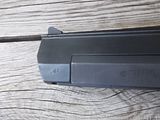|
|
Post by mrblackcat on Sept 12, 2017 23:36:45 GMT
I am not an expert on Desert Eagle Pistols... I have looked at most every one I have seen at a gun show in the last 30 years. Not that I was ever looking for this, but has anyone ever seen this, or know what it means? The Desert Eagle .44 / .41 (yes, in that order)   It looks like some of the early transition period pistols (like my Mk VII/Mk XIX .50AE Pistol)... by that I mean grind marks on the slide and barrel showing a bit, If you have never seen this before, it is mild, but visible, just not sterile/smooth like later Desert Eagles. Also, inconsistent "body lines"... my slide lines don't match up with the new MK XIX barrels I have recently bought. Even the muzzle brake I had installed matches the profile of my slide better than it matches the modern barrel. Anyway... any thoughts on why this slide is stamped backwards? MrBlackCat |
|
|
|
Post by boxilar on Oct 26, 2017 19:56:36 GMT
Probably from an early run of .41/.44 guns. The slide release is not in the photo, can you remember if it is a single or three step slide release? I think there were a small number of MkI .41/.44 guns made. If this is an early .41/.44, it is probably a MkI. Characteristics of the MkI are a single step slide release, teardrop shaped safety levers and a nonadjustable single stage trigger. The MkVII has a three step slide release, hook shaped safety levers and a two stage adjustable trigger. To add to confusion, there was also a 1000 unit run of .357 Magnum production prototypes. These start at serial number 3001 and look pretty much like MkI Desert Eagles, but cannot accept barrels or conversion kits from later guns. The quickest way to spot one is that the production prototype guns have traditional land and groove rifling instead of polygonal rifling.
|
|
|
|
Post by mrblackcat on Oct 26, 2017 23:39:36 GMT
Thank you for the reply... I have learned a bit about this gun since I bought it. It is a Mark VII. It was an early factory transition model when the .41 magnum was released. There are many pre-.41 guns with only .44 magnum on them. The .41 and slash are clearly added later as the font and stamp depth are smaller. .41 has been fun to shoot, but honestly, I can't tell it from .44 Magnum... except maybe when I am buying ammo for it.  MrBlackCat |
|
|
|
Post by boxilar on Oct 27, 2017 5:35:41 GMT
My brother and I were at a local gun shop looking at some new production Smith & Wesson revolvers in .44 Magnum and .41 Magnum. Someone asked us what the difference between .41 Magnum and .44 Magnum was and my answer was ".41 Magnum makes a slightly smaller hole." My brother is an engineer so he gave a more detailed answer that basically said that because of the thinner profile .41 Magnum would drop slightly less than .44 Magnum. .41 Magnum is an interesting cartridge but doesn't really do anything .44 Magnum can't do. I think the reason the Desert Eagle is still around while all the other automagnums have gone away is because you can buy off the shelf revolver ammo for the .357 and .44 models. The AMT .44 Automag had very limited ammo availability, tha LAR Grizzly had a another occasionally made cartridge in the .45 WinMag and the Wildey was also fed by ammo you had to load yourself. Desert eagle shooters could grab ready to go ammo or even feed it with cartridges bought for the revolver the already had. .41 Magnum has a following, but it's not easy to find. I think that's why it was dropped when MRI consolidated everything into the MkXIX.
|
|